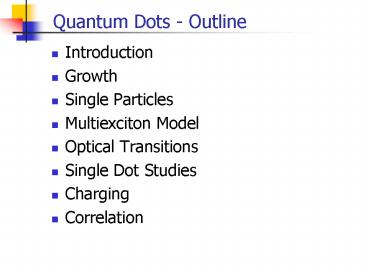Quantum Dots - Outline PowerPoint PPT Presentation
1 / 38
Title: Quantum Dots - Outline
1
Quantum Dots - Outline
- Introduction
- Growth
- Single Particles
- Multiexciton Model
- Optical Transitions
- Single Dot Studies
- Charging
- Correlation
2
Density of States
3
Fabrication of QDs
4
Sample Growth
5
Growth
6
STM images
7
Growth
Atomic Force Micrograph images (bottom) of
islands epitaxially grown on a gallium
arsenide-(001) substrate, and schematics (top) of
the profile of the islands showing their shape
and distribution. The islands are transformed
into quantum dots or rings by covering them with
a GaAs epitaxial film. (a) Indium arsenide
islands are randomly nucleated on the surface.
The islands are shaped like truncated pyramids
with a base of 3040 nm and a height of 48 nm.
(b) InxGa1xAs ring-shaped islands are randomly
distributed on the substrate. The depressed
center of the ring can be seen as a small black
dot in the image. (c) InAs islands on a GaAs
substrate form a two-dimensional lattice with a
unit cell (indicated in white) containing three
to four islands per lattice point. The lattice is
formed by patterning the substrate before
nucleation with a periodic mesa pattern
incorporating localized stress centers under the
mesas. Nucleation takes place preferentially on
top of the mesas in order to minimize the film
energy on the surface and relax local elastic
stresses.
8
Spectroscopy of quantum dots ensembles
9
Electron energy level
10
Energy Level Effective mass
11
Wave Function
Six lowest electron wave functions, Green
positive Blue negative The energy of the wave
functions increase from left to right and from
top to bot tom. The first functions is s-like,
then follow 2 p-like functions and at the bottom
3 d- like.
12
Multiexciton - Uncorrelated States
13
The Multiexciton Model Energy level
14
(No Transcript)
15
Splitting
Fermions interaction
Degeneracy1
Degeneracy6
Degeneracy9
(0,0)
(1,0) (0,1)
(1,1)
16
(No Transcript)
17
3-exciton
18
(No Transcript)
19
(No Transcript)
20
Optical Transition Energies as a Function of
Exciton Number in the QD
The magnitude of the energy splitting and the
spectral redshift for higher multiexcitons
rapidly decrease with the number of excitons,
causing the reduction of the transition energy to
converge to a finite value.
21
Single Dot Studies
22
QD made of QW Fluctuation
23
Diffraction-limited confocal microscope setup.
24
Line scan
25
Single QD
26
Emission intensity
27
Rate Equations
ni the probability of finding an i-exciton in
the QD.
28
Charging
29
Charge states
30
Charging (X,X-)
Ceh Cee Chh
Unlike higher dimensionality systems,where
negative or positive charging always results in
reduction of the emission energy due to
electron-hole pair recombination,in our
dots,negative charging reduces the emission
energy,relative to the charge-neutral case,while
positive charging increases it. Model
calculations reveal that the enhanced spatial
localization of the hole wave function,relative
to that of the electron in these dots,is the
reason for this effect.
e-
Cee
Ceh
h
e-
Ceh
Positive charging
Negative charging
Cee ltCeh lt Chh
Cee ltCeh lt Chh
e-
e-
Cee
Ceh
Ceh
Ceh
e-
h
h
h
Ceh
Chh
31
Polarization
32
Single Quantum Dot - Photoluminescence
GaAs
33
PL Spectra From Excited SCQD
CW excitation
6X
3Xs,3Xp
X
E. Dekel et al., PRB 62, 11 038 (2000).
34
Correlation Function
j
i
D1
MC
PL
Energy
Ij (t1)
MC
D2
Ii (t2)
correlator
I(t) - Intensity
35
Time Correlated Single Photon Counting Confocal
Spectroscopy Setup
Laser excitation Pulsed or cw
Vacuum chamber
Cold finger
T15K
PL emission
Si APD 2
t2
Monochromator 2
Polarized BS
start
TAC
MCA
Monochromator 1
Vt1-t2
t1
stop
Si APD 1
Counter
36
Correlation Function
Intensity correlation function for a quantum-dot
single-photon source based on pulsed laser
excitation of a single quantum dot embedded in a
microdisk. Plotted are the correlation function
for the titanium-sapphire excitation laser (top)
and quantum-dot ground-state emission under
excitation conditions (bottom), as a function of
the time delay t between the photon arrival
times. The absence of a peak at t 0 in the
emission correlation function shows that none of
the pulses contains more than one photon.
37
Pulse Correlation Function
PL
coincidence counts
auto correlation
cross correlation
38
CW Correlation Function
D.V. Regelman et al. PRL 87 257401 (2001)
39
Application of QDs

